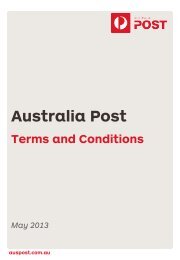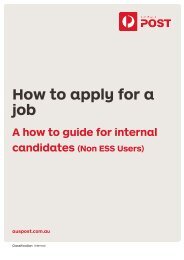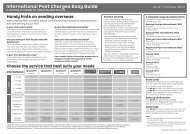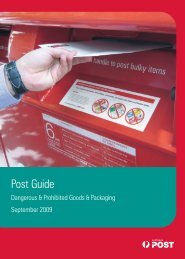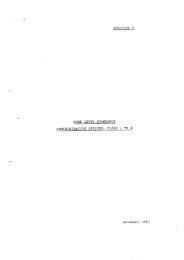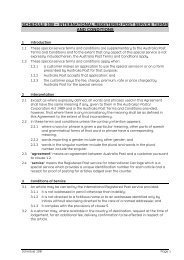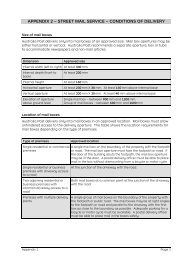Australia Post Annual Report 2008–09
Australia Post Annual Report 2008–09
Australia Post Annual Report 2008–09
You also want an ePaper? Increase the reach of your titles
YUMPU automatically turns print PDFs into web optimized ePapers that Google loves.
is increased to its recoverable amount.<br />
That increased amount cannot exceed<br />
the carrying amount that would have been<br />
determined, net of depreciation, had no<br />
impairment loss been recognised for the asset<br />
in prior years. Such reversal is recognised<br />
in profit or loss unless the asset is carried at<br />
revalued amount, in which case the reversal<br />
is treated as a revaluation increase. After such<br />
a reversal the depreciation charge is adjusted<br />
in future periods to allocate the asset’s revised<br />
carrying amount, less any residual value,<br />
on a systematic basis over its remaining<br />
useful life.<br />
(aa) Trade and other payables<br />
Trade payables and other payables are carried<br />
at amortised cost; however, due to their<br />
short-term nature, they are not discounted.<br />
They represent liabilities for goods and<br />
services provided to the group before the<br />
end of the financial year that are unpaid and<br />
arise when the group becomes obliged to<br />
make future payments in respect of the<br />
purchase of these goods and services.<br />
(bb) Interest-bearing liabilities<br />
All borrowings are initially recognised at the<br />
fair value of the consideration received less<br />
directly attributable transaction costs. After<br />
initial recognition, interest-bearing borrowings<br />
are subsequently measured at amortised cost<br />
using the effective interest method.<br />
Borrowings are classified as current liabilities<br />
unless the group has an unconditional right<br />
to defer settlement of the liability for at least<br />
12 months after the balance sheet date.<br />
(cc) Finance costs<br />
Finance costs are recognised as an expense<br />
when incurred. The group does not currently<br />
hold qualifying assets but, if it did, the<br />
borrowing costs directly associated with this<br />
asset would be capitalised (including any other<br />
associated costs directly attributable to the<br />
borrowing and temporary investment income<br />
earned on the borrowing).<br />
(dd) Provisions (excluding<br />
employee benefits)<br />
Provisions are recognised when the group<br />
has a present obligation (legal or constructive)<br />
as a result of a past event, it is probable that<br />
an outflow of resources embodying economic<br />
benefits will be required to settle the<br />
obligation and a reliable estimate can<br />
be made of the amount of the obligation.<br />
When the group expects some or all of a<br />
provision to be reimbursed – for example,<br />
under an insurance contract – the<br />
reimbursement is recognised as a separate<br />
asset but only when the reimbursement is<br />
virtually certain. The expense relating to any<br />
provision is presented in the income statement<br />
net of any reimbursement.<br />
Provisions are measured at the present<br />
value of management’s best estimate of the<br />
expenditure required to settle the present<br />
obligation at the balance sheet date using a<br />
discounted cashflow methodology. The risks<br />
specific to the provision are factored in to the<br />
cashflows and hence a risk-free government<br />
bond rate relative to the expected life of the<br />
provision is used as a discount rate. If the<br />
effect of the time value of money is material,<br />
provisions are discounted using a current<br />
pre-tax rate that reflects the time value of<br />
money and the risks specific to the liability.<br />
When discounting is used, the increase in<br />
the provision due to the passage of time is<br />
recognised as a financing cost. The increase<br />
in the provision resulting from the passage<br />
of time is recognised in finance costs.<br />
(ee) Employee leave benefits<br />
(i) Wages, salaries, annual leave<br />
and sick leave<br />
Liabilities for wages and salaries (including<br />
non-monetary benefits) expected to be settled<br />
within 12 months of the reporting date are<br />
recognised in other payables in respect of<br />
employees’ services up to the reporting date.<br />
Liabilities for annual leave where the<br />
corporation does not have an unconditional<br />
right to defer settlement of the liability for at<br />
least 12 months after the reporting date are<br />
recognised in current provisions at the<br />
amounts expected to be paid when the<br />
liabilities are settled.<br />
No liability is recognised for sick leave as<br />
benefits lapse with termination of employment<br />
and experience indicates that the pattern of<br />
sick leave taken is less than the entitlement<br />
accumulating.<br />
(ii) Long-service leave<br />
The liability for long-service leave is<br />
recognised and measured as the present<br />
value of expected future payments to be<br />
made in respect of services provided by<br />
employees up to the reporting date using<br />
the projected unit credit method.<br />
Consideration is given to expected future<br />
wage and salary levels, experience of<br />
employee departures, and periods of service.<br />
Expected future payments are discounted<br />
using market yields at the reporting date on<br />
national government bonds with terms to<br />
maturity and currencies that match, as<br />
closely as possible, the estimated future<br />
cash outflows.<br />
(iii) Workers’ compensation<br />
The corporation is a licence holder under the<br />
Safety, Rehabilitation and Compensation Act<br />
1988 (SRC Act). The corporation self-insures<br />
its liability for workers’ compensation. Claims<br />
are recognised in the financial statements<br />
and measured by the discounted value of<br />
an annuity. The adequacy of the provision<br />
is established by reference to the work<br />
of an actuary as at balance date, with the<br />
estimate of present value taking into account<br />
pay increases, attrition rates, interest rates<br />
and the time over which settlement is made.<br />
In accordance with its SRC Act licensing<br />
conditions, the corporation has a bank<br />
guarantee to cover its outstanding actuarial<br />
established claims liability (see Schedule of<br />
Contingencies). The corporation also complies<br />
with a requirement to maintain reinsurance<br />
to limit its workers’ compensation liabilities.<br />
The corporation has recognised a liability<br />
for workers’ compensation of $111.3 million<br />
at balance date (see note 20), of which<br />
$7.8 million relates to claims made in the<br />
<strong>2008–09</strong> financial year (2007–08: $4.8 million).<br />
(iv) Separation and redundancy<br />
A liability is recognised for separation<br />
and redundancy benefit payments for<br />
ongoing major restructuring only where<br />
the corporation is demonstrably committed<br />
to the restructuring and the cost can be<br />
reliably measured (see note 20). Generally<br />
such assessments do not exceed the certainty<br />
of initiatives planned for the following year.<br />
(ff) Pensions and other<br />
post-employment benefits<br />
The defined benefit plan requires contributions<br />
to be made to a separately administered fund.<br />
The cost of providing benefits under the<br />
defined benefit plans is determined using the<br />
projected unit credit actuarial valuation<br />
method. Actuarial gains and losses are<br />
recognised in retained earnings.<br />
Past service cost is recognised immediately<br />
to the extent that the benefits are already<br />
vested; otherwise it is amortised on a<br />
straight-line basis over the average period<br />
until the benefits become vested.<br />
The defined benefit asset or liability recognised<br />
in the balance sheet represents the present<br />
value of the defined benefit obligation,<br />
adjusted for unrecognised past service cost,<br />
net of the fair value of the plan assets. Any<br />
asset resulting from this calculation is limited<br />
to past service cost, plus the present value of<br />
available refunds and reductions in future<br />
contributions to the plan.<br />
<strong>Australia</strong> <strong>Post</strong> <strong>Annual</strong> <strong>Report</strong> <strong>2008–09</strong> | Financial and statutory reports 69




